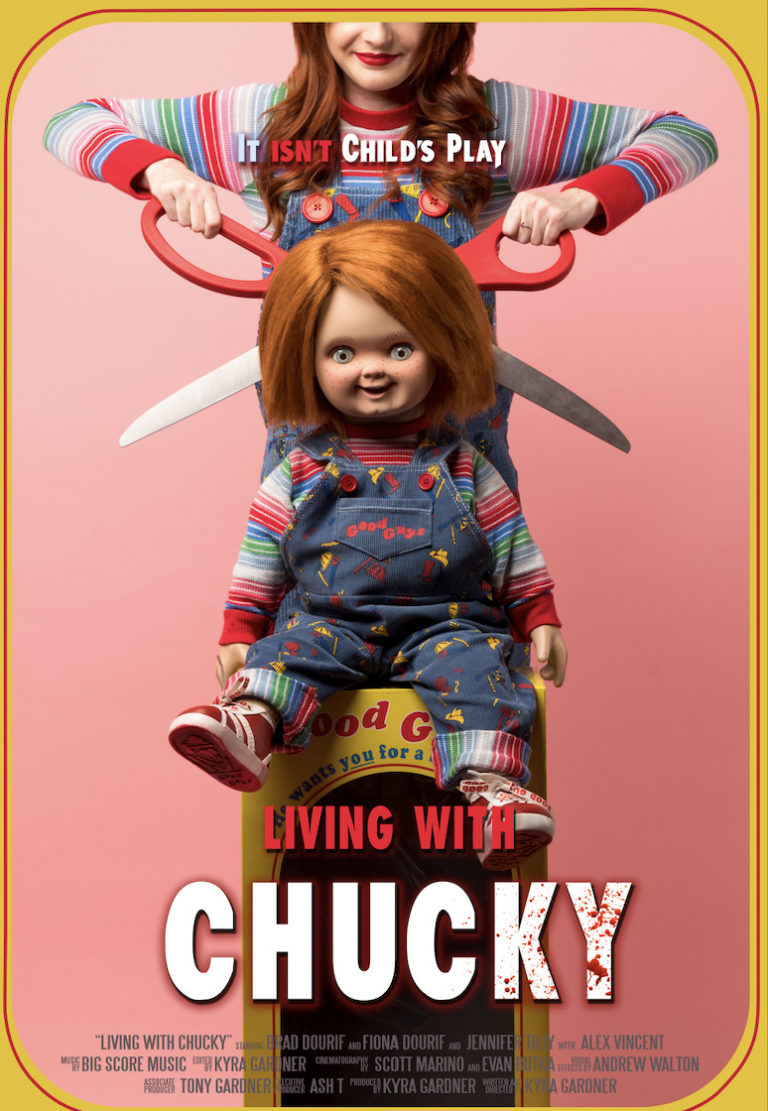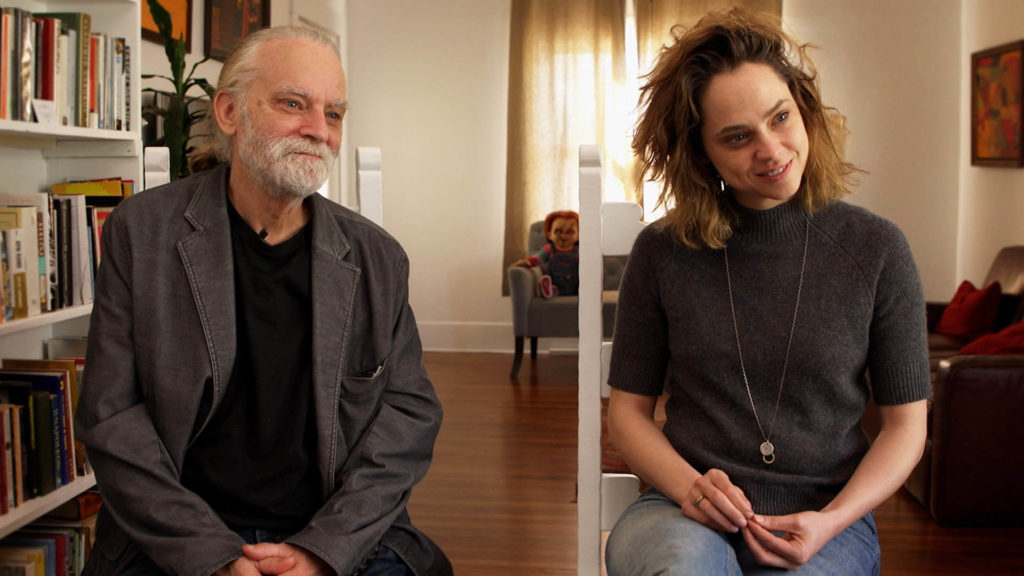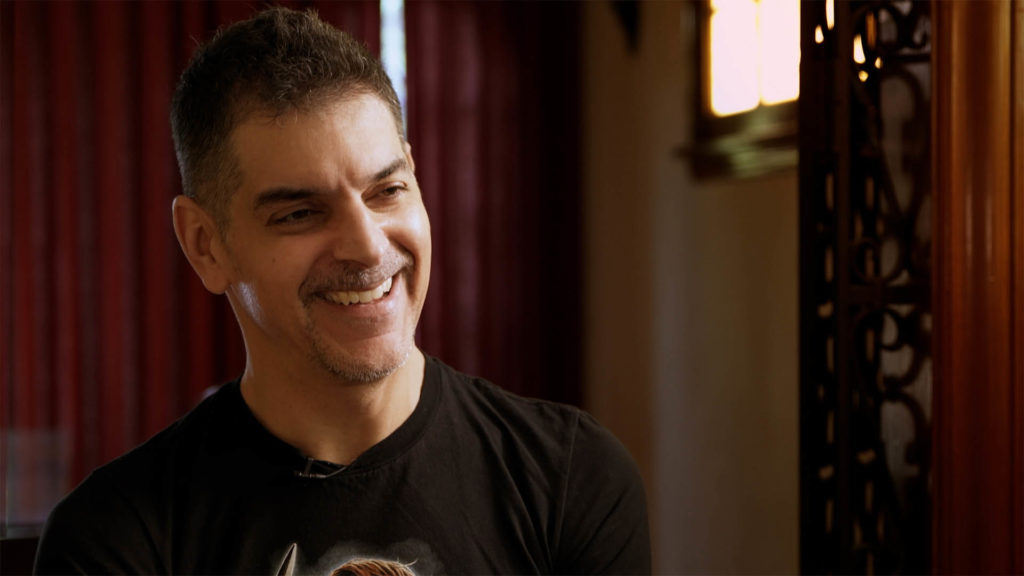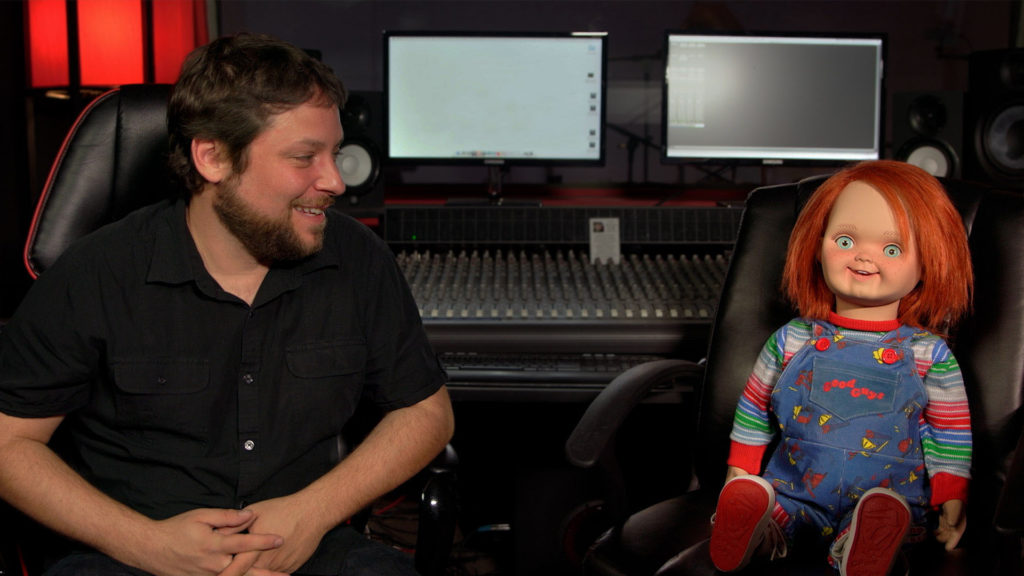

Exclusive Interview with Kyla Elise Gardner
Q: Tony Gardner, your father, is the puppeteer for Chucky and a makeup designer. What were the circumstances that led you to initially make a short film and eventually a feature?
KEG: It originally started in film school. I went to Florida State University to pursue a degree in filmmaking, specializing in directing. They had a semester focused on documentaries, which I never thought I was going to dive into. It wasn’t a genre that I was super-interested in. Then, getting into it, we watched some documentaries that really inspired me to make something personal.
I originally thought I would make it on what it was like to grow up with an SFX artist as a dad. Then somebody encouraged me to focus on a subset of that, which would be Chucky. He had been working on the franchise since I was around four. It’s been my whole life, practically, of having this doll involved in my life in some capacity and my dad working on that franchise.
I switched the focus to being about what it’s like to grow up with that, and that’s what inspired the short film. It did really well in festivals, and fans seemed to respond to it. I had so much footage already. I thought, well, if people like this, I’m sure they’d love a feature film. Also, the franchise deserves a feature film documentary, because they’d been doing it for 30 years.
Q: You were surrounded by the dolls growing up. Did you ever visit the Chucky set where your father worked?
KEG: Actually, they never shot in the U.S., they shot in Romania. Everything else that my dad has been [involved with] was in Canada. That’s also probably why this movie felt very special, because it really was separate. All the dolls and stuff were at home and involved in my childhood growing up. I never got to be involved, to see what my dad was actually working on.
Obviously, there would be some things that would film in L.A. — they did the “Curse of Chucky” reshoots in L.A. when I was, I think, 13 or 14. That was my first introduction to being on set and seeing it. But not in its full capacity. I have yet to visit that set since they filmed abroad.
With Season 1 of the TV show, I was going to visit but Covid hit and the borders were closed. So there was no visiting my dad then. With this second season, I meant to get up there, but there were still Covid protocols with filming, and I was finishing up with the documentary.
Q: What was amazing about the Chucky series was the expression of the faces. Sometimes it has an innocent look of a child, then it goes to a look a little bit like Jack Nicholson in “The Shining”. What can you say about the transformations of the doll’s faces by the crew members?
KEG: His look has definitely changed over time from the original 1988 [film, “Child’s Play”] to the series now. But it’s all been the same animatronics. Chucky seems to get a new look every [film], but it’s motivated. That’s really why I wanted to focus parts of the doc on the puppeteering work and what goes into it.
As you can see, it takes three people to operate those facial expressions that you’re seeing. It’s really hard work for them to think of it as one facial movement. It’s crazy. I think a lot of people don’t realize that — “Oh, it’s Chucky” — but actually there’s five Chuckys on set.This doll is a sitting doll, and the next doll is one with animatronics and its eyes move. So it’s interesting to see how it’s progressed.

Q: Some people in Hollywood might be surprised when producer David Kirschner bought Don Mancini’s script after he had worked with Steven Spielberg on “An American Tail.” He has a lot of respect for artists and filmmakers, and his long partnership with Mancini goes back 30 years.
KEG: It’s also interesting to be around the age that Don was when he first wrote that script. David Kirschner took a leap of faith on Don’s script at the time; it was called “Blood Buddy.” Putting myself in his shoes, it was like, “Wow, if I had somebody who just worked with Steven Spielberg, took a chance on me to make this movie” and it also has these insane things that for 1988 — those animatronics were not really done before to that capacity — it was so huge.
In the interviews, you can see their admiration for each other — and their respect, too in the way they speak about one another. It was a business relationship at first, and then, over time, it evolved into this thing where they had so much appreciation for each other to continue creating together. [And] on such a long-lasting franchise — I think it’s one of the only horror franchises that hasn’t been rebooted like crazy.
Q: Brad Dourif, who plays Chucky, was the actor who was in “One Flew Over the Cuckoo’s Nest.” He’s been doing more voice acting over some 20 years. Now he’s passing the baton to his daughter Fiona, who’s in the “Chucky” TV series. What is their relationship like?
KEG: “One Flew Over the Cuckoo’s Nest” is one of my favorite books. It’s so cool to meet Brad, the Academy Award nominee, transferring from live acting to voiceover acting — it’s so interesting to hear him talk about that. He actually loves voiceover work. He also voices for video games, which is so cool.
He clearly has a love for the character [of Chucky], especially getting into “Cult of Chucky.” He gets to do three different voices for three different Chuckys, which is cool. He keeps getting to do new things throughout his voice work on the franchise.
Now, with his daughter Fiona being in the franchise, you can tell that there’s such admiration between the two and a respect.
In “Cult of Chucky” she embodies her dad. And in the series, she has had the opportunity to actually play the younger version of her dad. I don’t think it’s anything that they expected but it’s a cool part of their relationship that they both got to play this character that’s so iconic, that’s so rare in horror franchises, and so special.
Q: The production tries to stick with the doll Chucky. They don’t want to do a CGI Chucky. It’s like enhanced images of CG Yoda as opposed to the “Empire Strikes Back” Yoda. Talk about their devotion to keeping the doll Chucky and how audiences feel about that?
KEG: That’s why the franchise has continued not only to go on, but go on with such love from the fans: because it is all practical, it’s a real doll. It also makes the movies and the series feel that much more real, because you know it’s an actor interacting with something actually on set. They’re looking into his actual eyes, which — if you’ve looked into Chucky’s eyes while he’s doing his animatronic thing — it’s actually quite scary.
There has been such a push to keep him practical when the film industry in general has gone so much more towards CGI. I think horror fans and the horror genre has always been counter-culture, so in a way it’s almost like the Chucky franchise is continuing to be counter-culture in not giving in to complete CGI or anything like that.
I think horror fans appreciate that consistency. They still get the feeling of a physical doll that they got in 1988 and now get in 2022 — which is so lovely. You can tell because when “Curse of Chucky” was coming out, there was a shot that actually was CGI in the trailer. [It was] because they couldn’t reveal that Chucky was taking off his skin and was still the same scarred Chucky from the previous movie. They had to digitally remove it for the trailer so that they didn’t give it away. Fans could tell that it was CGI and lost their minds on the internet. It just goes to show that they don’t want to see CGI Chucky, which I agree [with]. All the creators agree that it should remain practical. I think that’s the reason for its longevity.

Q: The original actor, Alex Vincent, was six years old when he was cast as Andy. How many people auditioned for the role?
KEG: Well obviously, [laughs] I was not alive when Alex Vincent was cast. It was interesting not only speaking to Alex but also to my dear friend Abigail Breslin, who was also an amazing child actor today, on how that goes.
In the documentary, we touch on when children are involved in a horror movie. If you have a good child actor, it’s 10 times more creepy because children don’t have that façade of really knowing that they’re acting. They’re really experiencing this thing, and we’re watching these poor children experiencing these things.
Alex Vincent definitely had that quality going into “Child’s Play 1” — that scene where he’s crying because Chucky’s coming to get him. He says in the documentary that he was actually breaking down because he was so nervous. You can tell that through the screen.
It’s like the little kid in the “E.T.” test screening who believed the creature was real — and had feelings for it — who totally broke down in his audition process. That’s exactly what happened with Alex Vincent. It’s so funny seeing six-year-old Alex in the first movie carrying around Chucky who is almost as big as him.
Q: The initial concept was a satirical take on marketing to children, when consumers bought toys like Cabbage Patch Kids and all that back then. Not only did Don Mancini have a great idea about that, but he created a circumstance in a totally family environment that people found so easy to work with. Can you talk about that?
KEG: As somebody who is on a much smaller scale directing puppets now myself, you really have to have an understanding of what it’s like to direct puppets. It’s a whole other ballgame from directing actors. The fact that Don has been with the franchise in its entirety, he really knows this character like the back of his hand. He’s editing in his mind while they’re shooting. It creates this wonderful work flow when you have somebody who knows the character so well because he created it. Also, he understands what the puppeteering takes and what it needs, having that shorthand on set with, not only the puppeteers, but the actors as well.
I think Don Mancini is very, very experienced at this point, and it shows when he is allowed to play with it. It’s interesting that it started as this satire on Madison Avenue and overconsumption. I think we see that more explored in “Child’s Play 2” with the toy factory. Don actually has a brief cameo in that movie. He’s in the hallway in the office scene, which is funny. He’s always been a voice behind it whether he couldn’t direct it and was writing it, or coming into the editing room. This is his baby, and he treats it as such. You can tell on set that there’s so much thought and care put into this character he’s created for 30 years.

Q: The Chucky films have had some pretty nasty killing scenes. Which stood out for you?
KEG: I didn’t watch it when it came out because I wasn’t alive during the time. But the whole concept of “Child’s Play 3” with the ending where the kids are going out to do this paintball match with each other and Chucky replaces everybody’s paintballs with bullets — that’s so disturbing to me. I don’t feel you could make that movie today. But that is the most effed-up, I think, of all the Chucky movies. It’s underrated, how cynical that was in that franchise. I don’t think “Child’s Play 3” gets enough credit for that.
Q: After making your film, do you have much more admiration and respect for the work of your father and other filmmakers?
KEG: I have always had the utmost respect and admiration for my dad. He is my hero. But yes, it’s been a lot more interesting to see everybody else’s perspective on this franchise — not just from the puppeteering aspect, but also from producing to directing to acting alongside it. I have a lot more admiration for the people involved in it — how much they love this franchise and put their whole selves into it.
Q: What do you want audiences to take away from this wonderful documentary?
KEG: I guess… How much it is a family and how much work goes on behind the scenes to bring your favorite killer doll onto screens at home. It’s really a huge team effort. I also wanted to take time in this documentary to showcase how much goes into the puppetry of the doll, especially nowadays on tighter budgets.
I think Chucky fans are really dedicated and opinionated in the greatest ways possible. But I hope that they take away how much goes into bringing them these characters, and how much everybody cares about it. I think that it shows through the movies and the series now. Hopefully, you can feel the love that they feel for it, through the screen and the documentary as well.

